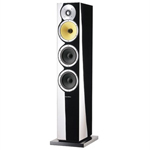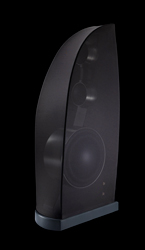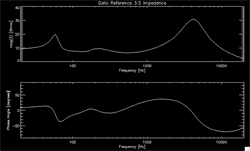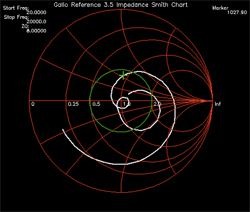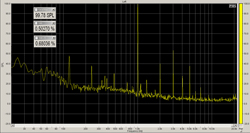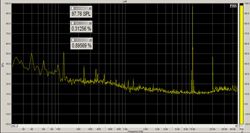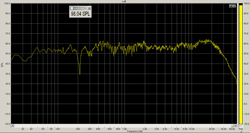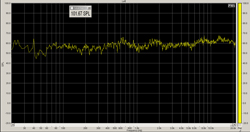Introduction
In 2007, I reviewed the Gallo Reference 3.1 speakers along with Gallo’s Reference AV center, A’Diva rears and the Reference SA subwoofer amplifier. I liked them so much I bought the entire system. Recently, Gallo has released the new Reference 3.5 speaker, replacing the venerable Reference 3.1. The new speaker looks outwardly very similar, but the MSRP has doubled. Anthony Gallo Acoustics promises that even of the speakers look similar, they deliver a significant jump in performance over the previous generation. In this review, I try to determine if the improvement in performance is worth the significant additional cost.
Specifications
- Design: Three-way Sealed Enclosures (No Crossover Network Involved; 125 Hz Filter at Woofer Binding Posts)
- Drivers: One 1″ Film Tweeter, Two 4″ Fiber Cone Midrange, One 10″ Aluminum Cone Woofer
- MFR: 34 Hz – 20 kHz ± 3 dB
- Nominal Impedance: 8 Ohms
- Sensitivity: 88 dB at 1 Watt and 1 Meter
- Power Handling: 350 Watts RMS
- Dimensions: 35″ H x 8″ w x 16″ D
- Weight: 47 Pounds/each
- Available Finishes: Matte Black, Brushed Stainless Steel with Matte Black Composite Base
- MSRP: $5999/pair USA; Optional Grilles: $390/pair
- Reference SA Amplifier to Drive the Woofers: $999 USA
- Upgrade from Reference 3.1 to 3.5: $3200/pair (Contact Anthony Gallo Acoustics for More Information)
- Anthony Gallo
Design
Last year, I also reviewed the Reference Strada stand mounted speakers with the separate TR-3 subwoofer. I absolutely loved those speakers, which clearly outperformed my Reference 3.1s. The new Reference 3.5s share many features with both speakers. The module containing the midrange and tweeters is identical between the Reference 3.5 and Strada. This module is mounted in a cast-aluminum strut that is the same as the previous Reference 3.1. This is combined with a new, ceramic cone dual voice coil woofer in a spun stainless steel enclosure.
This is a similar configuration to the previous 3.1, but with a brand new driver and re-designed enclosure. The driver is the same as used in the TR-3 subwoofer. The dual voice coils are configured the same as in the previous 3.1. One voice coil is connected to the main binding posts through a ~125 Hz low pass crossover. The other voice coil is connected to a second pair of binding posts on the speaker with no crossover present. This allows the use of an outboard subwoofer amp (with external crossover) to supplement the full range amplifier. This allows the sub amp to reinforce the bass response, extending all the way down to 20 Hz and allowing for room tuning. The Gallo Reference SA amplifier has continuously adjustable volume, crossover frequency for left and right channels independently, and provides 240 W per channel of power. Since I already had the Reference SA amp, I used it with the new 3.5s.
As with the 3.1, the 3.5 uses an almost-crossoverless design. The woofer and midrange are crossed-over with a simple 125 Hz filter. The midrange and tweeter use no electrical crossover. The midranges are carefully designed to intrinsically roll-off at higher frequencies without break-up or other problems. The midrange drivers are carbon fiber cone units that are bespoke for Gallo. Unlike the Reference 3.1, the 3.5 uses permanently mounted mesh grilles on the midranges. These have been carefully designed to optimize the loading on the driver. The cylindrical tweeter also uses no crossover, with the band limited via the design of the driver. This tweeter, shared with the Reference Strada, is a brand new driver that shares the cylindrical piezo film architecture of the unit in the 3.1, but is completely new. It too uses a new, mesh grille that also optimizes the loading of the driver.
The new speaker has a redesigned base. Rather than an MDF base with carpet spikes as used in the Reference 3.1, the 3.5 uses a heavy phenolic resin base with a polymer pad for decoupling from the floor. The designer, Anthony Gallo, says this material effectively decouples the speaker from the floor, and makes the speaker perform more consistently on a variety of floor types. With the previous spikes, the speaker would sound very good when placed on a very sturdy, vibration free floor, but would suffer on more flimsy platforms. The new, vibration damping material allows more optimal performance on a wider variety of surfaces.
While looking similar, the only component shared between the Reference 3.1 and 3.5 is the cast aluminum strut that is the backbone for the speaker. This strut is cast in two halves, and then welded together, ground smooth and painted with a thick, textured paint. This is the single most expensive component of the loudspeaker, and is primarily responsible for the price increase between the 3.1 and 3.5. Anthony Gallo explained that he had locked in the price on this component for the Reference 3.1, but the company that produces the strut had taken significant losses because of a much higher than expected reject rate. The company then passed along a price increase to Gallo that would have resulted in a huge price increase on the Reference 3.1. Rather than pass on this big increase in price with no improvement in performance, Gallo set out to redesign the 3.1 from the ground up to make a speaker worthy of the increased cost. The result is the 3.5, with every component redesigned and significantly upgraded with the exception of the aluminum strut that started the whole process.
The Reference 3.5 contains a whole alphabet soup of technologies that Gallo has developed. Some of these are used in all Gallo speakers, others make their debut in the 3.5. The first is S2. This is a fiber flake material made from a polyolefin plastic. This material fills all the driver enclosures and the entire strut assembly the driver enclosures are mounted to. This material helps damp standing waves, stops reflections, and acts as mass loading for the driver. The acoustic back wave coming from the driver couples to this material, and the material resists motion, creating damping. All Gallo speakers are filled with this material, and have been for some time.
OPT Level 1 is another technology that helps with time alignment of the drivers to optimize impulse response. This technology has to do with the mechanical mounting of the drivers. Everything, whether it likes it or not, is subject to Newton’s third law of motion: for every action there is an equal and opposite reaction. How does this come into play with a speaker? Well, when the speaker cone is pushed forward by the magnet, the speaker basket is pushed backwards. If the speaker basket can move, it will. This motion will result in time domain smearing of a transient. Anthony Gallo of course realized that no matter how hard one might try to make the driver mounting rigid, the speaker basket will always move, at least a little bit. OPT Level 1 tunes the materials and design of the driver mounts so they all move by the same amount under this reaction force, optimizing the transient response.
OPT Level 2 is a new technology that is new for the Reference 3.5. For years, Anthony Gallo has been annoyed that the sound of his speakers seemed to change based on how the speaker cables were routed, and what kind of floor covering those cables were sitting on. He surmised that this effect was caused by the electric field created by the musical signal in the speaker cable interacting with the floor (which is a dielectric). OPT Level 2 uses special speaker cables that have a helical wire wrapped around the two signal carrying conductors. This wire is attached to the positive amplifier terminal at the amplifier, but is left as an open circuit at the opposite end. The positively charged wire (which carries no current) is meant to prevent the interaction of the signal carrying conductors from interacting with the outside dielectric (i.e. the carpet). A banana jack on the outside of the speaker just above the binding posts mates with this wire coming out of the Gallo OPT Level 2 speaker cable and continues the shielding into the speaker, all the way to the tweeter. The speaker is still perfectly usable with normal speaker cable. Jumpers are supplied so the user can connect the positive amp terminal to the banana jack, giving the OPT Level 2 improvements inside the speaker with normal speaker cable. For this review, Gallo supplied their OPT Level 2 cables, which I used for some of the review. I switched back to my normal cables (used with the supplied jumper) for the balance of the review so I could compare.
A note for current Reference 3.1 owners. Gallo will upgrade your 3.1s to 3.5s for $3200. This currently is an exchange program, meaning people who send back their 3.1s will get a brand new pair of 3.5s. In the future, the 3.1s may be recycled. The only part that will be used is the aluminum strut, but as mentioned before that’s the single most expensive part of the speakers to build. If you’re interested in this possibility, you should contact Anthony Gallo Acoustics directly, rather than your original dealer.
Setup and In Use
I set up the Gallo 3.5s in my room in the same location as my 3.1s, but toed in towards the listening position as recommended by the user manual. I replaced my normal speaker cables with the OPT Level 2 equipped cables sent along with the speakers for the first half of the review period. The speakers were powered at the full range binding posts by my Emotiva XPA-1s. I used the Gallo Reference SA subwoofer amp to power the second voice coils in the same configuration I used with the older 3.1s. I initially tuned gain, phase and crossover frequency by ear using my previous experience with the 3.1s. I later tweaked these settings when I measured the response of the speakers at the end of the review, but I had gotten pretty close by ear. I took this route since most people don’t have measurement tools. I also didn’t want to color my opinions of the sound by measuring the speaker first. I let the speaker break-in for a few weeks of home theater duty before any serious listening got underway.
Once I did start listening, the Reference 3.5s were as welcome as an old pair of slippers, only better. I hoped that the 3.5s would deliver all of the advantages of the Strada system I recently reviewed, without any of their weaknesses as compared to the 3.1s. The new speakers delivered. The 3.5s best the 3.1s in absolutely every area bar none, and also give up nothing to the Stradas (other than in price tag). One of the main advantages of the Strada is the exceptionally wide, tall and deep soundstage. One issue did not mention in the Strada review is the height of the soundstage. The Strada soundstage is about 1ft. above the speakers, which were on very tall, 40″ high stands. This leads to a somewhat unnaturally high soundstage. Some might like this, but I found it a little distracting. The 3.5s also deliver a soundstage about 1 ft. above the speaker, but the height of the 3.5 is less, making the delivered soundstage more natural. The soundstage width was every bit as good as the Strada, but with even better, more natural positioning of images within the soundstage. In Emiliana Torrini’s “Fisherman’s Woman”, the simply produced acoustic guitar and voice sounded beautifully round, deep and spacious, without sounding artificially stretched. By comparison, I remember the soundstage of the Stradas sounding a bit exaggerated by comparison: a little wider, deeper and taller than natural.
Retrieval of detail was similar to the Stradas. I can’t say the 3.5s have any advantage here, except in the bass. Still, compared to other speakers I’ve had the pleasure to listen to, the 3.5s and the Stratas are at the very top in the ability to extract every last bit of detail out of a recording. The only speakers I’ve listened to that best the 3.5s are the Legend Tikandis with the DEQ-X room correction system. Realize, this system is more than three times the cost of the Reference 3.5s.
The one place where the Stradas did not clearly best the 3.1s was in the bass. While they played with plenty of depth and agility, the impact and dynamic contrast of the stereo woofers of the 3.1s seemed a bit better. The Reference 3.5s take care of that complaint. The new bass drivers on the 3.5, combined with the Gallo Reference SA subwoofer amplifier truly deliver world-class bass performance. They play all the way to 20 Hz (see the measurements section), offer exceptionally smooth and even bass frequency response, and deliver stomach-pounding impact when called for. Even more impressive was the smoothness and integration of this bass power. The TR-3 subwoofer blended well with the Stradas, but the woofers in the 3.5 deliver even better integration with the midrange and tweeter.
Every once in a while, I would be reminded with the Strada/TR3 system that I had a separate subwoofer. No such issue with the Reference 3.5s. The Daft Punk bass torture test was passed with flying colors. Human After All delivered organ-vibrating power, with shocking transients. This was combined with absolutely NO sense of the bass being “separate” from the rest of the spectral range. It’s this spectacular bass performance that costs you the extra $3,000 clams over the Strada system. You could remedy this with dual TR3s and still be $2,000 ahead, but you’ll never get the bass integration and smoothness delivered by the 3.5s. It’s an axiom of high-end audio that bass is expensive. If you don’t care much about the bottom octave, and you’re not a card carrying bass head, the Strada/TR3 system might be the best choice. If you want world-class bass performance, while keeping all the other magic of the Strada, the Reference 3.5 is the only choice. Yes, that last bit of performance costs a considerable amount of money, but what did you expect? Something for nothing?
After listening to the 3.5s using the Gallo supplied OPT2 speaker cable, I switched back to my normal speaker cable, Wireworld Eclipse. The sound did change, but I couldn’t really pick out a clear winner. The Gallo speaker cables seemed to be a little more detailed, and definitely had a more forward presentation (i.e. the soundstage was a little closer). The Wireworld speakers seemed to have more round, three-dimensional images and a soundstage that was set a bit farther back. If I didn’t already have good cables, I would certainly consider the Gallo cables to go with the 3.5s, but I don’t think it would be worth replacing an already good pair of cables. This is particularly true if you don’t have noise pickup or interaction issues with your current cables.
On the Bench
I measured the Gallo Reference 3.1s with my M-Audio Profire 610 firewire audio interface, with a calibrated Earthworks M30BX microphone and Spectra Plus FFT analysis software. Electrical impedance was measured with a Smith and Larson Woofer Tester 2, calibrated with a 10 ohm 1% resistor.
Here, we see the measured electrical impedance presented as traditional amplitude and phase plots and on a Smith chart, normalized to 8 ohms. As with the Reference 3.1, the Reference 3.5 has widely varying impedance, particularly in the treble. The impedance of the tweeter is highly capacitive, with a magnitude that varies by a factor of 10 from 3 kHz to 20 kHz. The impedance of the 3.5 is slightly more challenging to drive than the 3.1 at low frequencies, reaching close to -50 degrees phase angle and more than 16 ohms magnitude. This very variable electrical impedance is the penalty for the crossoverless design of the 3.5, and will require an amplifier with good stability and control.
Total harmonic distortion was measured at 50 Hz, 1 kHz and 10 kHz with tones normalized to 100 dB SPL at 1m (calibrated at 1 kHz with a Radio Shack SPL meter). THD is about 2% at 50 Hz, about 0.5% higher than the Strada-TR3 combination. This seemed to be a byproduct of using the dual voice coil drive with the Reference SA amp. With this amp turned off, the 50 Hz THD dropped to about 1.5%, in line with the TR-3 measurement. At 1 kHz, the THD measured at 0.5%, a bit better than the Strada. At 10 kHz, the THD drops to 0.3%. These are very good numbers for a speaker with no active correction.
Frequency response was measured at 1m distance on-axis from one speaker, at the listening position with the speakers playing in stereo mode. The test tone was white noise at 100 dB SPL at 1m. The 1m response shows a bit of a bump at high frequencies on axis with the tweeter, a room suckout at 200 Hz, and a bit of a drop off in bass below 40 Hz. At the listening position, the response is much smoother. The treble bump is gone for the most part (there’s a little bit of tilted-up treble present). The big room suckout at 200 Hz is gone, but smaller room features are present at 55 Hz, 45 Hz and 40 Hz. Bass response is more or less flat all they way to 20 Hz. For a speaker of this size and price, this performance is exceptional, particularly in the bottom octave. This is evidence of the advantage the 3.5 has over the Strada/TR-3 combination, which can’t match the low frequency extension of the 3.5.
Conclusions
The Gallo Reference 3.5 is most definitely a step up from the Reference 3.1 and the Strada/TR3 combo I recently tested. It’s clearly better in every way than the 3.1, and improves significantly on the Strada, which was already better than the 3.1, except perhaps in the bass. Is it worth the extra dough as compared to the Strada? Is it worth upgrading an existing pair of 3.1s? For me, the answer to that is yes. I will be replacing my 3.1s with the new 3.5s. They’re worth every dime, in my opinion.


